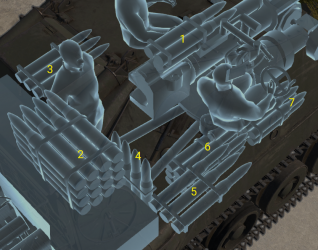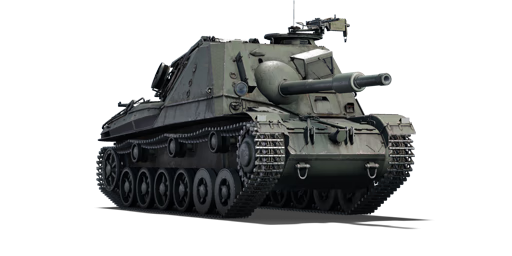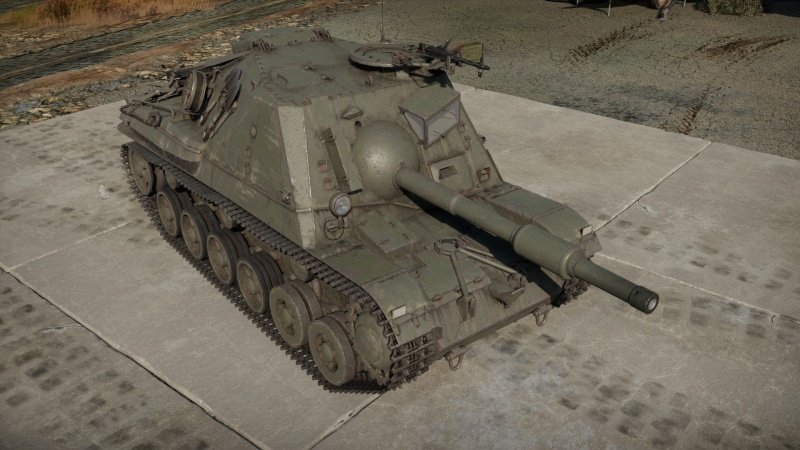Difference between revisions of "Pvkv m/43 (1963)"
Colok76286 (talk | contribs) (Edits) |
PixelFox450 (talk | contribs) (→Usage in battles) (Tag: Visual edit) |
||
| Line 126: | Line 126: | ||
<!-- ''Describe the tactics of playing in the vehicle, the features of using vehicles in the team and advice on tactics. Refrain from creating a "guide" - do not impose a single point of view but instead give the reader food for thought. Describe the most dangerous enemies and give recommendations on fighting them. If necessary, note the specifics of the game in different modes (AB, RB, SB).'' --> | <!-- ''Describe the tactics of playing in the vehicle, the features of using vehicles in the team and advice on tactics. Refrain from creating a "guide" - do not impose a single point of view but instead give the reader food for thought. Describe the most dangerous enemies and give recommendations on fighting them. If necessary, note the specifics of the game in different modes (AB, RB, SB).'' --> | ||
| − | The Pvkv m/43 (1963) has a casemate design, and as such, plays best as a sniper. With mediocre armour compared to its peers, it will depend on positioning or tank support in order to survive to deliver its shots. Move with tanks to your front, or find a long range sniping position in order to remain effective and support your team. | + | The Pvkv m/43 (1963) has a casemate design, and as such, plays best as a sniper. With mediocre armour compared to its peers, it will depend on positioning or tank support in order to survive to deliver its shots. Move with tanks to your front, or find a long range sniping position in order to remain effective and support your team. The main hinderance of the Pvkv m/43 is its size, which makes it an easy target when it is exposed in any way. In one-on-one engagements the Pvkv m/43 is better, since it gets to use its stronger frontal armor and competent gun to its advantage. |
=== Pros and cons === | === Pros and cons === | ||
Revision as of 22:38, 14 October 2023
| This page is about the Swedish tank destroyer Pvkv m/43 (1963). For the other version, see Pvkv m/43 (1946). |
Contents
Description
The Pansarvärnskanonvagn m/43 (1963) is a rank III Swedish tank destroyer with a battle rating of 4.7 (AB) and 5.0 (RB/SB). It was introduced in Update 1.97 "Viking Fury".
General info
Survivability and armour
Armour type:
- Rolled homogeneous armour (hull, superstructure)
| Armour | Front (Slope angle) | Sides | Rear | Roof |
|---|---|---|---|---|
| Hull | 20-30 mm (80°) Upper glacis 70 mm (32°) Centre and lower glacis |
30 mm | 20 mm Upper plate 20 mm (30°) + 5 mm Lower glacis |
20-30 mm (10°) Front glacis 5-9 mm (20°) Engine compartment |
| Superstructure | 70 mm (30°) Front glacis 80 mm (21°) Driver viewport 70 mm (spherical) Gun mantlet |
30 mm (12°) Front 25 mm (24-27°) Rear |
25 mm (9°) | 9 mm (5°) Front 9 mm (17°) Rear |
| Cupola | 9 mm (cylindrical) | 9 mm | ||
Notes:
- Suspension wheels, tracks and torsion bars are 15 mm thick.
- Storage boxes and mudguards are 4 mm thick.
Mobility
With 324 horsepower for 25 tons of mass, the Pvkv m/43 (1963) will only keep up with allied medium and heavy tanks, and barely keep up with the main crossfires and positions. Although the top speed is listed as 47 km/h, most of the time on the ground you will cruise at 30 to 35 km/h. Any obstacle like a river, mud, or even a 20 degree climb will be a very difficult task for this vehicle. You won't be able to retreat quickly either, with only -6 km/h in reverse.
| Game Mode | Max Speed (km/h) | Weight (tons) | Engine power (horsepower) | Power-to-weight ratio (hp/ton) | |||
|---|---|---|---|---|---|---|---|
| Forward | Reverse | Stock | Upgraded | Stock | Upgraded | ||
| Arcade | 51 | 6 | 25 | 460 | 618 | 18.4 | 24.72 |
| Realistic | 47 | 6 | 287 | 324 | 11.48 | 12.96 | |
Modifications and economy
Armaments
Main armament
| 75 mm pvkan m/43 | Turret rotation speed (°/s) | Reloading rate (seconds) | |||||||||||
|---|---|---|---|---|---|---|---|---|---|---|---|---|---|
| Mode | Capacity | Vertical | Horizontal | Stabilizer | Stock | Upgraded | Full | Expert | Aced | Stock | Full | Expert | Aced |
| Arcade | 43 | -15°/+20° | -13°/+20° | N/A | 7.0 | 9.8 | 11.8 | 13.1 | 13.9 | 8.71 | 7.70 | 7.10 | 6.70 |
| Realistic | 4.8 | 5.6 | 6.8 | 7.5 | 8.0 | ||||||||
Ammunition
| Penetration statistics | |||||||
|---|---|---|---|---|---|---|---|
| Ammunition | Type of warhead |
Penetration @ 0° Angle of Attack (mm) | |||||
| 10 m | 100 m | 500 m | 1,000 m | 1,500 m | 2,000 m | ||
| slpgr m/43 | APCBC | 149 | 146 | 132 | 116 | 102 | 89 |
| sgr m/38 | HE | 18 | 17 | 16 | 14 | 13 | 12 |
| slpprj m/49 | APDS | 232 | 228 | 213 | 196 | 180 | 165 |
| Shell details | ||||||||||||
|---|---|---|---|---|---|---|---|---|---|---|---|---|
| Ammunition | Type of warhead |
Velocity (m/s) |
Projectile mass (kg) |
Fuse delay (m) |
Fuse sensitivity (mm) |
Explosive mass (TNT equivalent) (g) |
Ricochet | |||||
| 0% | 50% | 100% | ||||||||||
| slpgr m/43 | APCBC | 890 | 6 | 1.2 | 14 | 110 | 48° | 63° | 71° | |||
| sgr m/38 | HE | 840 | 6.43 | 0.2 | 0.1 | 690 | 79° | 80° | 81° | |||
| slpprj m/49 | APDS | 1,110 | 2.6 | - | - | - | 75° | 78° | 80° | |||
Ammo racks

| Full ammo |
1st rack empty |
2nd rack empty |
3rd rack empty |
4th rack empty |
5th rack empty |
6th rack empty |
7th rack empty |
Visual discrepancy |
|---|---|---|---|---|---|---|---|---|
| 43 | 42 (+1) | 26 (+17) | 23 (+20) | 19 (+24) | 16 (+27) | 7 (+36) | 1 (+42) | No |
Machine guns
| 8 mm ksp m/36 | ||||
|---|---|---|---|---|
| Mount | Capacity (Belt) | Fire rate | Vertical | Horizontal |
| Pintle | 2,000 (250) | 648 | -10°/+65° | ±180° |
Usage in battles
The Pvkv m/43 (1963) has a casemate design, and as such, plays best as a sniper. With mediocre armour compared to its peers, it will depend on positioning or tank support in order to survive to deliver its shots. Move with tanks to your front, or find a long range sniping position in order to remain effective and support your team. The main hinderance of the Pvkv m/43 is its size, which makes it an easy target when it is exposed in any way. In one-on-one engagements the Pvkv m/43 is better, since it gets to use its stronger frontal armor and competent gun to its advantage.
Pros and cons
Pros:
- Starts with a stock APCBC found on the previous Pvkv m/43 (1946) and Strv m/42 DT
- Has access to a powerful APDS
- Great gun depression of -15°
- Relatively mobile
- Wide horizontal gun arc
Cons:
- APDS is a tier IV modification
- Outdated chassis - narrow tracks and light armour
- Casemated tank destroyer - dead engine = dead Pvkv
- Tall silhouette makes tank vulnerable at hull-down position
- Poor reverse
- Low survivability
- Thin roof armour - 20 mm shells can penetrate the top of the tank, knocking out the crew
History
During World War 2, the need for tank destroyers became evident, and Germany had great success with the StuG III and StuG IV. Because of the success of those platforms, Sweden decided to create a tank destroyer similar in concept to the StuG's. Landsverk created a design in 1942, based on the chassis of the Strv m/42. It was chosen by the Swedish military and was given the designation Pansarvärnskanonvagn m/43, or Pvkv m/43 for short.
The Pvkv m/43 used the chassis of the Strv m/42, but with a casemate superstructure replacing the turret. The superstructure was located at the front of the vehicle, and the glacis was sloped. It had an open tarp to keep the weight down, and used a tarp to protect the crew from the elements. The Pvkv m/43 had a crew of 4, and was initially armed with a 75 mm luftvärnskanonen m/36 antiaircraft gun, modified with a longer barrel for increased armour penetration. The gun could traverse 15 degrees to the left and right. It had a Ksp m/39 machine gun as the secondary armament. It was powered by a Volvo A8B engine producing 360 hp. The gearbox was different than the gearbox of the Strv m/42, and the drive wheels had to be reinforced to handle the increased weight of the vehicle. The Swedish military ordered 87 Pvkv m/43 in 1942, but deliveries were delayed and the last vehicle was delivered in 1948.
In 1954, the vehicle was given an armoured roof to better protect the crew. Other improvements included a muzzle brake, a gun travel lock, and a bore evacuator/fume extractor. The Strv m/41 was retired from service in 1957, which allowed the two Scania-Vabis L603 engines per vehicle to be used in the Pvkv m/43. The two L603 engines produced less horsepower (320 hp) than the Volvo A8B, but were much more reliable. In 1970, the Pvkv m/43 was retired from service, and the guns were used in static fortifications until 1995.
Media
- Skins
See also
Links to the articles on the War Thunder Wiki that you think will be useful for the reader, for example:
- reference to the series of the vehicles;
- links to approximate analogues of other nations and research trees.
External links
References
- Bibliography
- Pansarvärnskanonvagn m/43. (2020, April 6). In Wikipedia. https://en.wikipedia.org/w/index.php?title=Pansarv%C3%A4rnskanonvagn_m/43&oldid=949440407
| AB Landsverk | |
|---|---|
| Light Tanks | |
| L-10 | Strv m/31 |
| L-60 | Strv m/38 · Strv m/39 · Strv m/40L |
| Pbil m/40 | Pbil m/40 |
| Strv 74 | Strv 74 |
| Unimog 404 | U-SH 405 |
| Medium Tanks | |
| Lago | Lago I · Strv m/42 EH · Ikv 73 · Strv m/42 DT |
| Tank Destroyers | |
| Ikv 72 | Ikv 72 · Ikv 103 |
| Pvkv m/43 | Pvkv m/43 (1946) · Pvkv m/43 (1963) |
| Pvkv II/III | Pvkv II · Pvkv III |
| SPAA | Pvlvv fm/42 · L-62 ANTI II |
| Sweden tank destroyers | |
|---|---|
| Strv m/41 derivatives | Spj fm/43-44 · Sav m/43 (1944) · Sav m/43 (1946) · Pvkv II · Pvkv III |
| Ikv 72/103 | Ikv 72 · Ikv 103 |
| Pvkv m/43 | Pvkv m/43 (1946) · Pvkv m/43 (1963) |
| ATGM | UDES 33 · Pbv 302 (BILL) · Pvrbv 551 |
| Other | SAV 20.12.48 · Bkan 1C |
| Norway | VIDAR |





